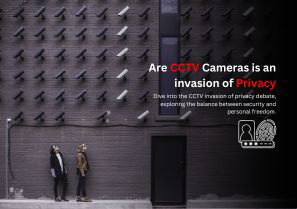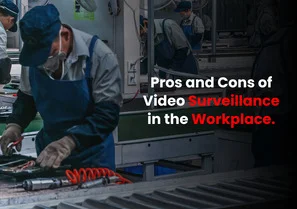In today’s world, security cameras have become ubiquitous, providing a sense of safety and protection in both residential and workplace environments. However, the use of video surveillance in the workplace remains a topic of debate, as concerns about privacy and the potential invasion of employees’ personal space arise. In this article, we will take an in-depth look at the pros and cons of video surveillance in the workplace, exploring the benefits it offers in terms of safety and security, as well as the potential drawbacks it may present.

Pros of Video Surveillance in the Workplace.
Increased Safety
One of the primary advantages of installing surveillance cameras in the workplace is the significant increase in safety. Research has shown that businesses can suffer substantial losses due to burglary and shoplifting, amounting to billions of dollars daily. However, properties with security cameras are less likely to be targeted by criminals. In fact, statistics indicate that approximately 60% of burglars move on to their next target if an alarm system is present. With video surveillance, businesses can monitor their premises in real-time, enabling them to detect and prevent any suspicious activity or crime before it occurs. Additionally, alarm monitoring systems can promptly alert authorities to intervene, further enhancing workplace safety.Documented Evidence
Another advantage of video surveillance in the workplace is the ability to provide documented evidence in the event of a crime or dispute. Surveillance cameras capture footage that can be instrumental in investigations, helping law enforcement and local authorities gather relevant information and identify potential suspects. In cases of employee disputes or allegations, video recordings can serve as unbiased evidence, aiding in resolving conflicts and determining the truth. Moreover, surveillance cameras can assist in uncovering instances of theft or asset misappropriation within the company, ensuring accountability and maintaining a professional environment.Deterrence of Harassment
Surveillance cameras can play a crucial role in curbing harassment in the workplace, particularly for female employees who may be more vulnerable to such incidents. By monitoring areas that are prone to harassment, such as poorly lit spaces or secluded rooms, surveillance cameras create a sense of security and deter potential offenders. The presence of video surveillance can encourage employees to report incidents without fear of reprisal, leading to a safer and more inclusive work environment. This proactive approach to preventing harassment demonstrates a company’s commitment to the well-being of its employees and fosters a positive workplace culture.Increased Productivity
Employees are more likely to remain focused and committed to their work when they know they are being monitored. Studies have indicated that employees spend a considerable amount of time engaging in non-work-related activities during working hours. However, when aware of live monitoring, employees tend to be more conscious of their responsibilities and are less likely to engage in distractions. This increased productivity benefits both the employees and the organization, leading to improved efficiency and performance.Compliance with Laws and Regulations
Video surveillance in the workplace can help companies ensure compliance with various laws and regulations. For instance, certain industries require strict adherence to safety protocols and standards. Surveillance cameras can capture any violations or unsafe practices, allowing organizations to take prompt corrective actions and prevent accidents or injuries. Moreover, in sectors where sensitive data or intellectual property is handled, video surveillance can help protect against unauthorized access or theft, ensuring compliance with data protection regulations.

Cons of Video Surveillance in the Workplace
Invasion of Privacy
While video surveillance undoubtedly provides enhanced security, it can also raise concerns about invasion of privacy. Employees may feel uncomfortable with the constant monitoring of their activities, leading to decreased morale and job satisfaction. It is crucial for organizations to strike a balance between ensuring security and respecting the privacy of their employees. Transparency and clear communication about the purpose and extent of surveillance can help alleviate privacy concerns and build trust within the workplace.Potential for Misuse
The presence of surveillance cameras can create a power dynamic that may be misused by employers or supervisors. If not handled ethically and responsibly, video surveillance can be used for purposes other than security, such as monitoring employee performance or personal activities. This misuse of surveillance footage can lead to a hostile work environment and a breach of employee trust. Therefore, it is essential for organizations to establish clear guidelines and policies regarding the use of surveillance cameras, ensuring they are solely employed for their intended purpose.Cost and Maintenance
Implementing and maintaining a video surveillance system can be a significant investment for businesses. The initial installation costs, as well as ongoing maintenance and monitoring expenses, can strain the company’s budget. Additionally, surveillance cameras require regular maintenance to ensure optimal performance and prevent technical glitches. Employing dedicated personnel to monitor the surveillance feed diligently is also necessary to maximize the effectiveness of the system. Organizations must weigh the financial implications against the benefits of video surveillance before making a decision.Legal Considerations
When implementing video surveillance in the workplace, it is crucial to consider the legal aspects and comply with applicable laws and regulations. In India, for example, the use of surveillance cameras is subject to data protection laws and privacy regulations. Employers must ensure that video surveillance is conducted within the boundaries of the law, respecting employees’ rights to privacy. It is advisable to seek legal counsel to understand the specific legal requirements and obligations related to workplace video surveillance.

Conclusion
Video surveillance in the workplace offers numerous advantages in terms of safety, security, and productivity. It can provide documented evidence, deter harassment, and ensure compliance with laws and regulations. However, it is essential for organizations to address concerns regarding privacy invasion, potential misuse, and the associated costs and legal considerations. Striking a balance between security and privacy is key to creating a positive and trusting work environment. By implementing video surveillance responsibly and transparently, businesses can reap the benefits while mitigating any potential drawbacks.
Remember, while video surveillance can enhance workplace safety, it should always be implemented ethically and in compliance with legal requirements.
In India, the use of video surveillance in the workplace is governed by the Information Technology (Reasonable Security Practices and Procedures and Sensitive Personal Data or Information) Rules, 2011, under The Information Technology Act, 2000. These rules outline the obligations and responsibilities of organizations when collecting and processing personal data through surveillance cameras. It is important for businesses to familiarize themselves with these regulations and ensure compliance to avoid any legal implications.
Read more about Laws regarding CCTV laws in India
Legal consideration of CCTV usage in India






